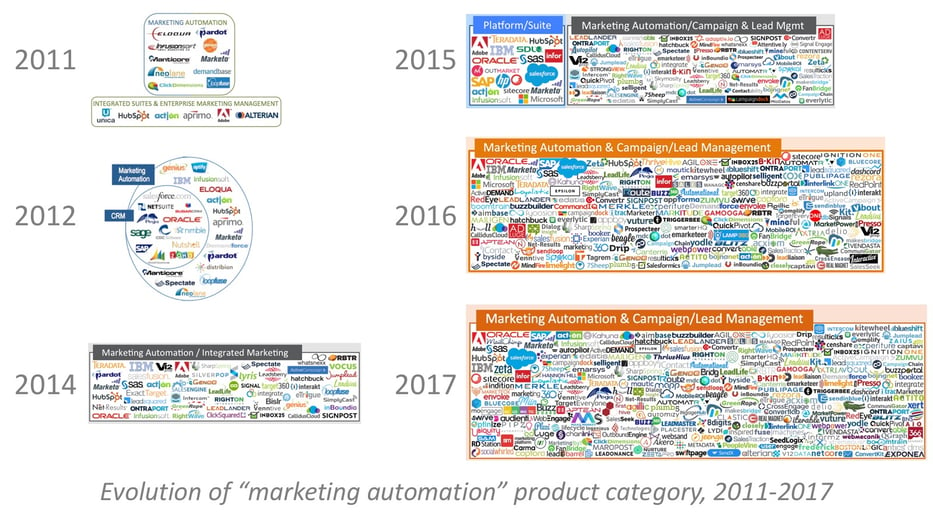Is marketing automation necessary for smaller institutions?

Advances in marketing technology happen every day and your institution has probably already heard about marketing automation for banks (maybe even from us). Just look at how crowded the vendor marketplace has become in the past six years. In a single year (from 2016 to 2017) the marketplace grew by 36%.

Consumers are getting this level of personalization from other businesses and are translating these expectations onto their financial institutions. This demand was reflected in a recent article by The Financial Brand. When asked about the most important trends for retail banking in 2018, the top three answers could all be addressed through effective deployment of marketing automation.

- Marketing automation delivers the right message at the right time, removing friction from the relationship.
- Marketing automation captures data after every engagement and then leverages that data to make your marketing more effective.
- The data and automated scale of an effective marketing automation platform allow community banks and credit unions to deliver an integrated experience across multiple channels.
But as a local bank or credit union, your resources are already stretched thin and you might be thinking, “I don’t have time for that too. I know the megabanks do it, but they have way more resources than us and a bigger scale.”

It’s time to change that mindset. For community financial institutions, marketing automation can be a valuable tool that makes your life and your employees’ lives easier while increasing your marketing effectiveness and efficiency. It allows you to constantly maintain relationships with prospects and account holders at the click of a button so you have time to focus on innovative products, providing great service, and managing your teams.
Is marketing automation worth the cost for community banks and credit unions?
When you evaluate marketing automation vendors, the cost for a full-service tool might induce sticker shock. But when you consider the benefits the tool brings to your institution, the right one more than pays for itself.
Add-on: $13,800 a year
Hubspot: $15,000 a year
Salesforce Pardot: $24,000 a year
Oracle Eloqua: $48,000 a year
If you're doing some mental math, it could mean as few as 5 to 7 new accounts per month and your marketing automation platform has paid for itself.
There is also massive cost savings in marketing automation. A good platform will make life easier for your team rather than create more work. It takes an average of 70 days to build and deliver new marketing campaigns manually, but because some marketing automation platforms come complete with tested creative and compliance (look for a vendor that specializes in financial services for that), the time to deploy a new campaign is reduced to just minutes, giving you more time to knock out those other items on your to-do list. Plus, by choosing a vendor that already has relationships with other companies, you’ll often get access to low-cost media spots and big discounts on printed collateral, like direct mail.
Not to mention, people make mistakes. At a small institution, it's likely that you and your employees carry many responsibilities. It's inevitable that things will fall through the cracks. Marketing automation takes some of the more monotonous and time-intensive tasks off of your employees, and because it is an automated system, you can ensure predictable and repeatable results.

Segmenting consumers gets results.
Many institutions that are doing their marketing manually don't have a segmentation model to identify the best consumers in their market. These are the people who are most likely to open accounts with your institution and be profitable. Without knowing who they are, your marketing efforts are wasted on the wrong targets — like the 40% of checking accounts that aren't profitable.
A good marketing automation tool and vendor will utilize market analysis to locate the right consumers for you and connect with them on the channels they actually see (email, direct mail, paid search, social media, and more). When it comes to prospecting, this hyper-personalized, data-driven strategy can increase your number of engagements and number of accounts opened because you’re using your money to target the right people with the right message.

When using marketing automation for your community bank or credit union, your marketing will be triggered by consumer behavior. Since the customer triggers your marketing, you can be confident that the offer is more relevant. We all know that this will convert better, but there is a silent benefit: You aren't bombarding customers that aren't ready. This keeps your brand fresh and trustworthy in their mind, so when you do market it to them your message will resonate.
Collecting data improves your marketing over time.
The access to consumer data you’ll get from a marketing automation platform allows you to continuously improve your campaigns and make them more effective. You’ll be able to optimize your multi-channel programs based on past performance, consumer behavior, and new insights, so you can reach out with targeted offers or just to tell a current account holder happy birthday.
As you learn more about what works and what doesn’t, marketing automation also makes it easy and fast to duplicate successful campaigns quickly for new prospects.
Don’t let your size cause you to be left behind.
On average 51% of companies are currently using marketing automation. As our marketing landscape continues to change, this number is only going to grow and you don’t want your institution playing catch up.
By joining these companies who already use marketing automation, you’ll make your team more efficient, engage more consumers, and continue to develop long-lasting relationships with current account holders in just a few clicks.
What should banks and credit unions look for in a marketing automation platform?
- It must support the channels where your customers are; email, direct mail, radio, t.v., paid search, mobile, out-of-home, and social.
- Look for a cost that can be recovered with a realistically low number of accounts based off of your profitability. Understanding that an effective platform will allow for cross-selling and drive up account profitability.
- Look for partners, not vendors. There are plenty of marketing automation platforms out there, but when you choose one you are entrusting a large part of your marketing endeavors. This partner should have experience in the financial sector and be willing to work with you to accomplish your goals.
- Find a partner that is big enough to bring economic advantages through relationships with media sellers.
- Ask about their data security. Marketing automation runs on a lot of data and you want to make sure that you are keeping your consumers safe.
- Speaking of data, find a partner that has some data specialists on the team. Rather than making your own segments, you want partners who have an understanding of how to get you the best results as quickly as possible by leveraging your consumer's data.



